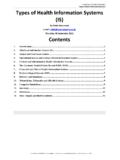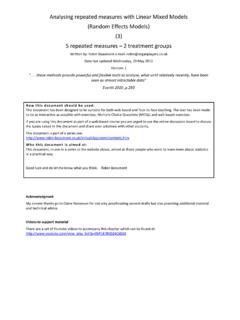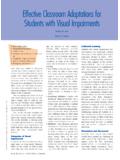Transcription of Principal Component Analysis Example - floppybunny.org
1 An introduction to Principal Component Analysis & Factor Analysis Using SPSS 19 and R (psych package). Robin Beaumont Monday, 23 April 2012. Acknowledgment: The original version of this chapter was written several years ago by Chris Dracup Factor Analysis and Principal Component Analysis (PCA). Contents 1 Learning 3. 2 Introduction .. 4. Hozinger & Swineford 1939 .. 5. 3 Overview of the process .. 6. Data preparation .. 6. Do we have appropriate correlations to carry out the factor Analysis ? .. 6. Extracting the Factors .. 8. Giving the factors meaning .. 9. Reification .. 10. Obtaining factor scores for 11. Obtaining the factor score coefficient matrix.
2 11. Obtaining standardised scores .. 11. The 11. What do the individual factor scores tell us? .. 12. 4 Summary - to Factor analyse or not .. 13. 5 A typical exam question .. 14. Data layout and initial inspection .. 14. Carrying out the Principal Component Analysis .. 15. Interpreting the 16. Descriptive 16. Communalities .. 16. Eigenvalues and Scree Plot .. 17. Unrotated factor loadings .. 17. Rotation .. 18. Naming the 19. Summary .. 19. 6 PCA and factor Analysis with a set of correlations or covariances in SPSS .. 20. 7 PCA and factor Analysis in R .. 21. Using a matrix instead of raw data .. 23. 8 Summary .. 24. 9 Reference .. 24. C:\temporary from virtualclassroom\ Page 2 of 24.
3 Factor Analysis and Principal Component Analysis (PCA). 1 Learning outcomes Working through this chapter, you will gain the following knowledge and skills. After you have worked through it you should come back to these points, ticking off those with which you feel happy. Learning outcome Tick box Be able to set out data appropriately in SPSS to carry out a Principal Component Analysis and also a basic Factor Analysis . Be able to assess the data to ensure that it does not violate any of the assumptions required to carry out a Principal Component Analysis / Factor Analysis . Be able to select the appropriate options in SPSS to carry out a valid Principal Component Analysis /factor Analysis .
4 Be able to select and interpret the appropriate SPSS output from a Principal Component Analysis /factor Analysis . Be able explain the process required to carry out a Principal Component Analysis /Factor Analysis . Be able to carry out a Principal Component Analysis factor/ Analysis using the psych package in R. Be able to demonstrate that PCA/factor Analysis can be undertaken with either raw data or a set of correlations After you have worked through this chapter and if you feel you have learnt something not mentioned above please add it below: C:\temporary from virtualclassroom\ Page 3 of 24. Factor Analysis and Principal Component Analysis (PCA).
5 2 Introduction This chapter provides details of two methods that can help you to restructure your data specifically by reducing the number of variables; and such an approach is often called a data reduction or dimension reduction . technique. What this basically means is that we start off with a set of variables, say 20, and then by the end of the process we have a smaller number but which still reflect a large proportion of the information contained in the original dataset. The way that the information contained' is measured is by considering the variability within and co-variation across variables, that is the variance and co-variance ( correlation).
6 Either the reduction might be by discovering that a particular linear componation of our variables accounts for a large percentage of the total variability in the data or by discovering that several of the variables reflect another latent variable'. This process can be used in broadly three ways, firstly to simply discover the linear combinations that reflect the most variation in the data. Secondly to discover if the original variables are organised in a particular way reflecting another a latent variable' (called Exploratory Factor Analysis EFA) Thirdly we might want to confirm a belief about how the original variables are organised in a particular way (Confirmatory Factor Analysis CFA).
7 It must not be thought that EFA and CFA are mutually exclusive often what starts as an EFA becomes a CFA. I have used the term Factor in the above and we need to understand this concept a little more. A factor in this context (its meaning is different to that found in Analysis of Variance) is equivalent to what is known as a Latent variable which is also called a construct. construct = latent variable = factor A latent variable is a variable that cannot be measured directly but is measured indirectly through several observable variables (called manifest variables). Some examples will help, if we were interested in measuring intelligence (=latent variable) we would measure people on a battery of tests (=observable variables) including short term memory, verbal, writing, reading, motor and comprehension skills etc.
8 Similarly we might have an idea that patient satisfaction (=latent variable) with a person's GP can be measured by asking questions such as those used by Cope et al (1986), and quoted in Everitt & Dunn 2001 (page 281). Each question being presented as a five point option from strongly agree to strongly disagree ( Likert scale, scoring 1 to 5): 1. My doctor treats me in a friendly manner 2. I have some doubts about the ability of my doctor X1 error 3. My doctor seems cold and impersonal 4. My doctor does his/her best to keep me from worrying X2 error GP. 5. My doctor examines me as carefully as necessary Personality 6. My doctor should treat me with more respect X3 error 7.
9 I have some doubts about the treatment suggested by my X4. doctor Patient error satisfaction Treatment 8. My doctor seems very competent and well trained X5. 9. My doctor seems to have a genuine interest in me as a person error 10. My doctor leaves me with many unanswered questions about my condition and its treatment X6 error 11. My doctor uses words that I do not understand X7 error 12. I have a great deal of confidence in my doctor 13. I feel a can tell my doctor about very personal problems X8 error 14. I do not feel free to ask my doctor questions GP. knowledge You might be thinking that you could group some of the X9 error above variables (manifest variables) above together to X10 error represent a particular aspect of patient satisfaction with Latent variables / factor their GP such as personality, knowledge and treatment.
10 So construct etc X11 error now we are not just thinking that a set of observed variables relate to one latent variable but that specific subgroups of X12 error them relate to specific aspects of a single latent variable X13 error each of which is itself a latent variable. Two other things to note; firstly often the observable Observed variables X14 error variables are questions in a questionnaire and can be thought of as items and consequently each subset of items represents a scale. C:\temporary from virtualclassroom\ Page 4 of 24. Factor Analysis and Principal Component Analysis (PCA). Secondly you will notice in the diagram above that besides the line pointing towards the observed variable Xi from the latent variable, representing its degree of correlation to the latent variable, there is another line pointing towards it labelled error.















